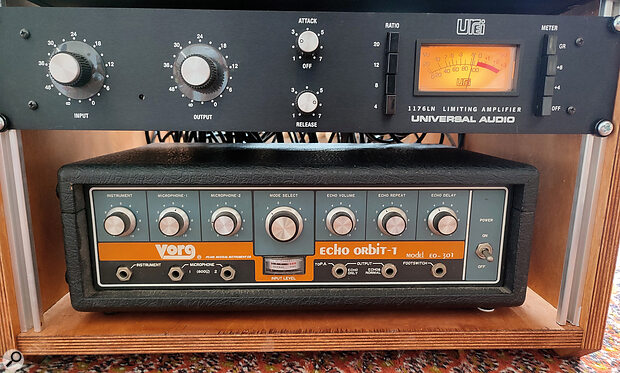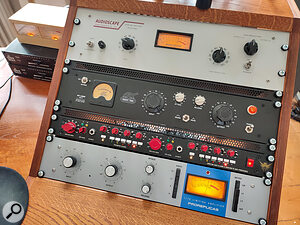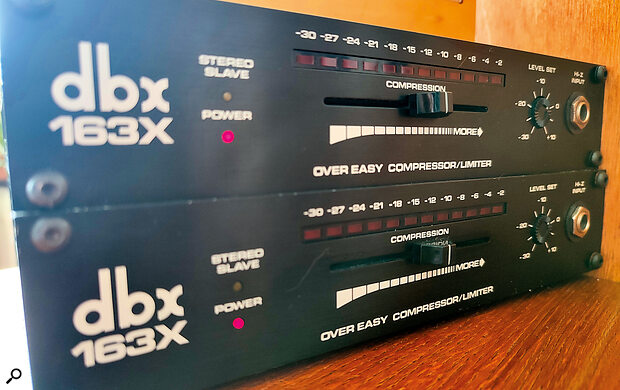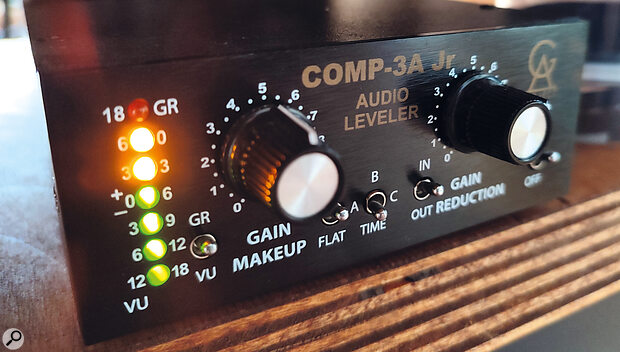Mix engineers used to prefer hardware to software because it sounded better. Is that still true? And if not, is there still a reason to use it?
The world of audio can be a strange one. People who have worked out of analogue studios for their whole career are selling all their gear and moving 'in the box', while smaller studios not too long in the game opt for expensive hardware gear and even install analogue consoles. There is more newly designed and manufactured hardware on the market than ever, whilst plug‑ins are getting better and better and more expensive. So what’s going on?
Better Or Different?
If you have ever visited one of the popular audio forums online, you will know that all those ‘hardware vs software’ discussions are filled with heat. They are basically endless and eventually lead to the same result: some say hardware is always better, and some say they don’t hear a difference. Let’s take a different, practical look on the matter.
If you received a set of plainly numbered audio files, one from a hardware unit costing £$2k and the others from plug‑in emulations, you’d expect one to sound noticeably better, right? The web is full of these blind shootouts, and I have done them and shared them myself. If you really take the time to match all contenders as closely as you can, you’ll find yourself hard pressed to form conclusions beyond “That one sounds a little duller, while that one sounds a little brighter.” Often, it’s a struggle to hear a difference at all. So if you can’t immediately hear a clear difference in terms of better or worse, then what’s the point of shelling out £$2k for that hardware unit?
Plug‑ins have come such a long way that most A‑list mixing engineers use them exclusively for mixing. Even longtime hardware advocates like Andrew Scheps and Michael Brauer have moved completely in the box. Yes, recalls and deadlines are a key factor, but you don’t believe these guys would have made such a move if they felt their mixes became worse, do you? Today, almost every piece of hardware, old or new, has been emulated in a plug‑in. So not only can people keep using their favourite gear, but they can use as many instances of it as they want and their CPU or DSP lets them. And all without the need for maintenance, or a substantial electricity bill.
If the best engineers in the world can and do make great‑sounding records in the box, the quality is good enough. However, there is still a case to be made for hardware, and this is especially true in the context of a home or project studio.
The Uniqueness Factor
For me, the discussion about plug‑ins vs hardware ends here in terms of quality. If the best engineers in the world can and do make great‑sounding records in the box, the quality is good enough. However, there is still a case to be made for hardware, and this is especially true in the context of a home or project studio: it can help you find a unique sound which is yours alone. And which, if it’s good, attracts potential clients to have you mix their stuff because they want that sound.
 The author’s 1176 compressor. Does it sound the same as yours?
The author’s 1176 compressor. Does it sound the same as yours?
Here’s a non‑debatable fact for starters: if you and I own the same plug‑in, we literally own the same thing. The code is the same for everyone. If, on the other hand, you and I both own hardware 1176 compressors, the chances are they will sound different. They will share a familiar character, but they will definitely not sound identical. My hardware 1176 is only mine. It’s unique. And so is yours. Mine may sound best on bass, yours on vocals. Awesome!
In a typical home or project studio scenario, budget is the key factor, and so you’ll likely take advantage of B‑stock deals and clones, or buy used since you can’t afford to simply buy the best units in each category. This increases the chances that your exact combination of gear is unique. Having only a few pieces of hardware also means you’ll take the time to really explore their potential, so you’ll end up using them in the way they shine the most. It has another benefit too: although it‘s great that we can all run virtually unlimited numbers of plug‑ins, the down side is the risk of using them just because you can. In a mixing context, everything you do should have a musical reason. Having only a limited number of hardware units forces you to use them where they have the greatest effect.
Maximising Potential
 Having a small but select range of hardware devices to work with makes you put in the work to figure out how to get the best from them.Every mixing engineer has a different way of working, but it’s probably true to say that almost everyone uses grouping or bussing for different elements of the mix. That’s where hardware is best used, in my opinion, because it affects many tracks at once. The obvious place to start is on your master bus, since this affects the entire mix. A great analogue compressor and/or EQ, or a multi‑faceted processor like the SSL Fusion, Neve Master bus Processor or Louder Than Liftoff Silver Bullet can make a lot of difference, even when set up in a subtle manner. Can you achieve the same result with plug‑ins? Probably, but you might need quite a few.
Having a small but select range of hardware devices to work with makes you put in the work to figure out how to get the best from them.Every mixing engineer has a different way of working, but it’s probably true to say that almost everyone uses grouping or bussing for different elements of the mix. That’s where hardware is best used, in my opinion, because it affects many tracks at once. The obvious place to start is on your master bus, since this affects the entire mix. A great analogue compressor and/or EQ, or a multi‑faceted processor like the SSL Fusion, Neve Master bus Processor or Louder Than Liftoff Silver Bullet can make a lot of difference, even when set up in a subtle manner. Can you achieve the same result with plug‑ins? Probably, but you might need quite a few.
Depending on the number of hardware processors you have, think about how you can route your tracks so that as many of them as possible can benefit from the processing. Set up a single parallel path for everything and blend that to taste, split your mix into music and vocals and give each of those two ‘master busses’ some analogue treatment: whatever sounds and feels good. Since pretty much every popular DAW has the ability to use hardware inserts, you don’t need a summing box and can easily try different setups and routings without the need for pulling patch cables. The only thing you need is enough free analogue ins and outs on your interface.
Building Up
Like many people, I’ve built up my own collection of studio hardware over a long period. I bought things when I had an idea how to incorporate them into my setup, to give me something I thought was lacking. And, of course, when I had some money to spare and some time to search for a good deal. First, I got a nice bus compressor. Then I got a nice vocal compressor. Then I got a nice drum compressor. Then a nice bass compressor which turned out to be killer as a second vocal compressor. Now, a couple of years later, I have a whole 16‑channel converter maxed out, as well as the six analouge ins and outs on my interface. My setup, which is based on Michael Brauer’s multi‑bus approach, has evolved over the years so I have the feeling every piece of gear is used where it sounds best. Every single track in the mix runs through at least two hardware processors along the way, and since they are incorporated as hardware inserts in my DAW, I can easily shift them around should I want to.
 Sometimes the most affordable hardware can be the hardest to recreate in software.
Sometimes the most affordable hardware can be the hardest to recreate in software.
I know the sound of this setup and every single piece that’s a part of it, which makes my mixing process intuitive and fast. This helps me getting a consistent sound that, at the end of day, is mine. Recall is not a big issue, thanks to the core philosophy of the multi‑bus approach, which is to calibrate your gear and then leave settings alone, so it reacts predictably on every single mix. I’m not saying my mixes sound better than anybody else’s, or that you listen to them and go, “Ah, that must be him, I can hear that certain hardware compressor tone on the vocals.” I’m saying the sound of my setup is as unique as the setup itself and it helps me make mixes my clients are consistently happy with. And that in turn makes me feel good and confident.
To repeat, I’m not claiming that hardware sounds better than plug‑ins per se. That is simply not true. In fact, I recently took the time to replicate every single piece of analogue gear I own in the box. Eventually, I was able to do so in such a way that you could hardly tell the difference. But in some cases it took me more than one plug‑in and it wasn’t easy. Ironically, the hardest ones to match were the cheapest units I have in the rack, namely the Golden Age Comp‑3A Jr and my pair of old dbx 163x compressors. These units have a unique sound that was really tough to replicate, so watch out for all those strange little boxes that may be had for cheap. Chances are they are full of character and have not yet been emulated as a plug‑in by five manufacturers. And who says that crappy old reverb for 80 bucks won’t work as a nice saturator when you drive the input?
The Illogical Conclusion
This article should have stopped right here, but you may be left thinking: “Since he can now recreate his sound in the box, why doesn’t he sell the hardware and go on a nice vacation? Especially since he never turns those big sexy knobs?” Good question. I’m afraid I can’t answer it. Maybe it’s just that real VU meters make me feel good, or because I have a story to tell for every single piece of gear I own. Whatever it is, I feel inspired every time I switch on the racks. And that’s key for making a great mix.
How I Do It Myself
Here is a list of my own analogue gear and how it is currently set up:
- Master bus: SSL Fusion with SSL XR626 bus compressor on the insert.
- Rhythm bus (drums, bass, percussion): Drawmer 1978 and Phoenix DRS‑Q4 Mk2 for EQ and transformer saturation.
- Instruments and effects bus (everything else except vocals): Smart C1 in dual‑mono mode.
- Vocal buses: Pro Replicas 1176 Rev.A, Weight Tank Vari‑Mu Compressor, AudioScape Opto, a channel of my Sebatron VMP‑4000e tube preamp with some crunch and the air EQ setting.
- Bass is split up into ‘body’ and ‘neck’ parts using EQ. The body has a Golden Age Comp‑3A Jr, neck a UREI 1176 Rev.D clone.
- Rhythm parallel bus: a pair of UREI Teletronix LA‑3A clones (these may be switched with the Smart C1 on the Instruments bus, depending on the track).
- Instruments and vocal parallel bus: Nekotronics SSL bus compressor with Carnhill transformers.
- Parallel master bus: a pair of dbx 163x OverEasy compressors (these may be switched with the LA‑3As on the Rhythm parallel bus, depending on the track).
- Global parallel bus: a pair of channels again from the Sebatron VMP‑4000e, crunched up with the bright EQ setting.
- Pearl Vorg Tape Echo: Used as an attitude effect for vocals and lead instruments.


